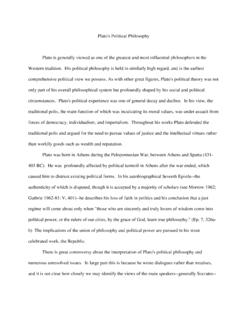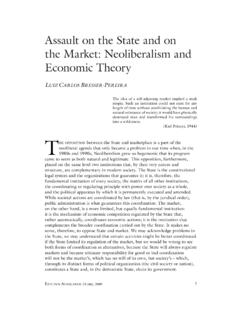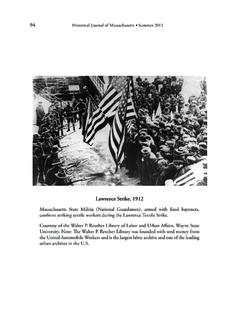Transcription of Department of Political Science DOCTORAL THESES
1 Department of Political Science DOCTORAL THESES for Tibor Malkovics s Dissertation SCRATCHING EACH OTHER S BACK? An Analysis of the Network of Relations between the Radical (National) Right and the Hungarian Guards Supervisor: Prof. Dr. Attila gh DSc. University Professor, Head of DOCTORAL School, BCE Dr. Zolt n Bal zs CSc. Associate Professor, BCE Budapest, 2010 1 Department of Political Science DOCTORAL THESES for Tibor Malkovics s Dissertation SCRATCHING EACH OTHER S BACK? An Analysis of the Network of Relations between the Radical (National) Right and the Hungarian Guards Supervisor: Prof. Dr. Attila gh DSc. University Professor, Head of DOCTORAL School, BCE Dr. Zolt n Bal zs CSc. Associate Professor, BCE Tibor Malkovics 2 Contents Contents .. 2 1. Theoretical introduction .. 3 Political and social background .. 3 Description of the research problem, the subject of research, the population and the observational unit.
2 5 2. Research structure, methodology, and THESES .. 7 Plurality of research 7 Structure of the dissertation .. 7 A new aspect of the research: SNA as a research method in Political Science .. 10 THESES .. 11 Sampling, methods of data collection and analysis: The examination of the network of relations between radical and extreme right-wing organizations .. 13 Time limits of the research .. 16 3. Results and new research findings .. 17 The most significant results of the research .. 17 The most important new findings of the dissertation .. 23 4. Major references .. 28 5. Writer s list of publications on the topic .. 30 3 1. Theoretical introduction Political and social background After the democratic turn there was an emergence of neonationalism and neotraditionalism in Central and Eastern Europe, too. As a new set of phenomena, this was strongly related to the characteristics and the outcome of the transition.
3 It entailed an emphasis on historical continuity and an urge to strengthen national identity, which gained importance especially in the newly established nation-states, due to the weak legitimacy of the new elites. Many politicians expected to gather ideological support for their Political goals from extreme nationalism, which, as a result of the reinterpretation of national identities as well as Political battles, motivated the reappearance of authoritarian tendencies. Although these trends seemed to become marginalized after the democratic consolidation, radicalism and extremism have remained strong in the Political arena. Similarly to the history of West European right-wing radical mobilization, it was again proven that crisis movements are inextricably linked with the turmoil generated by social transition and the problems of modernization deriving from the need to catch up with the West.
4 According to Sir Winston Churchill s ironic bon mot, democracy is the worst form of government, except for all those other forms that have been tried from time to time. We can thus assume as well that constitutional democracy, even with all its shortcomings, is the only possible means at present to achieve high-level legitimacy. Besides, democratic processes and institutions themselves will not result in less equality and more social vulnerability. Moreover, by the beginning of the 21st century democracy has become such a strong marker of the spirit of our time that even those Political parties that are openly right-wing claim to be national democrats or central democrats . Since theoretically each and every interest or ideology is free to find its organizational form in democratic regimes, the radical organizations are indeed bound to use real democracy as a catchword.
5 In those democracies where the law allows organizations to influence the work of the government and the 4 parliament, as well as decision-making, the protection of rights is theoretically effective in the case of radical groups, too (as it has been pointed out on several occasions by, for example, the hard core of the Fall 2006 rioters and the founders of the Hungarian guards themselves). As Philippe Breton writes, Democracy has the unique capacity .. to give space to other discourses, which are not necessarily democratic (Breton [2000] p. 54). As a result of this radical conditioning of democratic interests and needs, many researchers think that with the acceptance and strengthening of these radical claims, societies will soon get used to the idea that there is nothing wrong with violating the constitutional rights of minorities or breaking constitutional principles (see: Bayer [2002]; Decker [2003]; Betz [2004]; Cuperus [2006]).
6 Lately, we could hear such claims not only from former members of the new right but also the politicians of Jobbik The Movement for a Better Hungary (JMMP), who have frequently presented their exclusionary ideology through coded messages. What is the most alarming about this is that if these populist ideas about the people s rule are taken up by the Political elite, radical rhetoric will be elevated to the level of acceptable ideologies and incorporated into democratic discourse. This will easily lead to the destruction of the very constitutional basis of democracy. The blackmailing effected by national radicals will channel Political discourse in the public sphere in a way that some of their programs will become part of mainstream politics, thereby legitimizing a false notion of people s rule based on collectivism, as well as its related Political expectations.
7 This phenomenon is visible not only in Western Europe but in Central and Eastern Europe as well. In Hungary right-wing radicalism first emerged within the democratic parties that effected the regime change, and only later did it become an independent ideology. At the time of the democratic transition, radical factions in Hungary were formed within the legitimately operating moderate right-wing parties, which was not characteristic in Western European countries. Hungarian examples include Istv n Csurka and his plebeian populist wing in the Hungarian Democratic Forum (MDF), Izabella B. Kir ly, who 5 supported skinheads (members of the Hungarian Youth Association), or J zsef Torgy n, under whose leadership the skinhead youth faction within the Independent Smallholders Party (FKgP) enjoyed the party s support. Description of the research problem, the subject of research, the population and the observational unit In my dissertation I map the network of relations between Hungarian right-wing (national) radicals and the national guards that have existed since 2007, and show the similarities and differences between eastern and western versions of right-wing radicalism.
8 The results of this comparison may explain why the connection I just mentioned entails the formation of national guards (maybe with the exception of the Italian National Guard or the Black Guard ), since in several countries of Central and Eastern Europe the rise of right-wing radicalism came with the formation of semi-legal irregular forces. Hungary is in the forefront concerning the formation of these groups. Hungarian national guards were among the first ones to be formed in the summer of 2007, and in the same year the Budapest Prosecution Service was one of the first public authorities to apply for the dissolution of the Hungarian Guard Association for Protection of Traditions and Culture at the Court of Budapest. The prosecution service decided to submit an application for dissolution because it claimed that the Hungarian Guard broke the organizational law with its activity: its demonstrations and the public statements of its leaders qualified as discrimination and verbal violence against minorities.
9 The lawsuit started in March 2008, and the trial was first adjourned until May, then in December, after a long trial, the guard was dissolved. An appeal was submitted right away, so the court decision became final only on July 2, 2009. The reformulation of a legally dissolved guard movement also occurred first in Hungary, in the presence and with the assistance of the leaders of JMMP. They quoted an article of law that states that if a community (movement) does not qualify as a social organization, it can continue its activities. They argued that the organizational nature of the Hungarian Guard 6 does not conform to the legal definition of organizational structure, since it is not associated or connected with any association or other group that would legally qualify as an organization. Therefore, the Hungarian Guard was by no means the legal successor of the dissolved Hungarian Guard Association; consequently, it could not be accused of any illegal act which would obviously sanction the activity of the dissolved social organization.
10 For the same reason, the active members of the organization could not be penalized for offences on grounds of a government decree that had just come into effect. Similar arguments came up in lawsuits that were started for the dissolution of other guard-like forces. In the meantime, it could be seen on the Internet that the units commonly referred to as guards started to take off or update their websites. Thus, in the last part of my dissertation I try to prove, with the help of network relations analysis, that despite the obvious conspiracy concerning the guards , the relations both between the paramilitary organizations and the radical right-wing (national) Political organizations, and between the radical organizations and extreme right-wing organizations have remained intact. The reasons for this are the following: 1.







